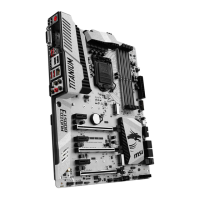
Do you have a question about the MSI Z170A MPOWER GAMING TITANIUM and is the answer not in the manual?
| Brand | MSI |
|---|---|
| Model | Z170A MPOWER GAMING TITANIUM |
| Category | Motherboard |
| Language | English |
Lists essential tools and components required for initial setup and assembly.
Illustrates audio port connections for 2, 4, 6, and 8-channel configurations.
Details the CPU socket, its alignment markings, and important handling precautions.
Provides guidance on installing memory modules, emphasizing DIMM2 slot first.
Details the bandwidth allocation for PCIe slots based on graphics card configuration.
Step-by-step guide on how to install an M.2 module onto the motherboard.
Instructions for connecting a U.2 SSD to the motherboard using the U.2 cable.
Explains methods to manage fan speed via BIOS or Command Center.
Details how to connect and enable the chassis intrusion detection feature.
Step-by-step guide to reset BIOS settings to default values using the jumper.
Table detailing LED statuses for CPU, DRAM, VGA, BOOT, and Slow Mode.
Explains the function of the Debug Code LED for POST progress and errors.
Explains methods to access the BIOS setup utility from the system.
Guide on updating BIOS using the M-FLASH utility via USB drive.
Configuration options for system date, time, and SATA port information.
Access to advanced settings like PCI Subsystem Settings.
Enables or disables the onboard LAN controller and its option ROM.
Selects the primary boot device for graphics output.
Sets system behavior upon AC power loss and restoration.
Enables or disables the secure boot function for system security.
Selects the system boot mode between Legacy and UEFI architectures.
Sets an administrator password for full BIOS access and system security.
Restores or loads all default BIOS values.
Sets the CPU ratio to determine CPU clock speed.
Allows CPU to run different base clock frequency steps dynamically.
Enables or disables Intel Hyper-Threading technology for multi-core processing.
Manages multiple overclocking profiles for saving and loading settings.
Allows manual control of fan speed based on CPU temperature.
Step-by-step guide to install Windows 7, 8.1, or 10 operating systems.
Adjusts CPU Ratio and Base clock for CPU frequency control.
Step-by-step instructions for updating the system using Live Update 6.
Optimizes display settings by reducing blue light and adjusting contrast.
Controls LED lighting effects on the motherboard.
Allows toggling between different hotkey categories (Windows, Login, MSI Smart Keys).
Manages user accounts and their access permissions.
Guides on creating and configuring a virtual RAM disk.
Enables or disables the USB SPEED UP feature on Windows startup.
Selects and adds videos or channels for viewing within Dragon Eye.
Guides on configuring internet upload/download bandwidth via Network Test.
Accesses Nahimic 2's audio effects, profiles, and settings.
Allows streamers to use prerecorded sounds for livestreams.
Switches the Sound Tracker feature on or off.
Lists hardware and software requirements for XSplit Gamecaster V2.
Buttons to start live streaming or recording gameplay.
Uploads recorded videos to YouTube after authorizing the account.
Lists major functions of Intel XTU like monitoring and tuning.
Guide on setting SATA mode to RAID and entering the IRST Option ROM.
Steps to create an M.2 PCIe SSD RAID volume using UEFI BIOS.
Steps to diagnose and resolve issues where the system does not power on.
Procedure to clear a lost BIOS password.
Compliance statement regarding FCC rules for digital devices.
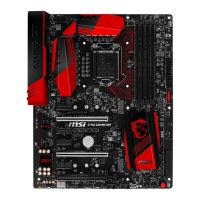
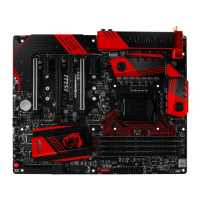
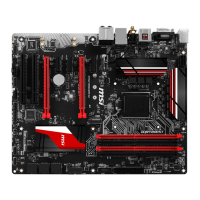
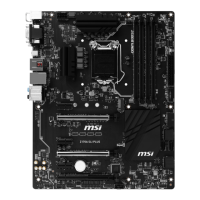

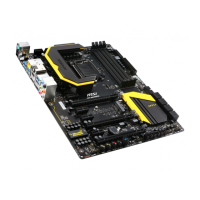
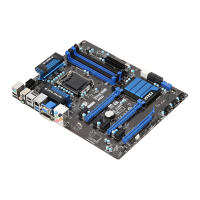
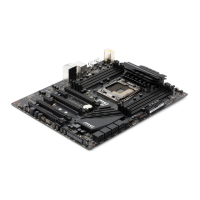
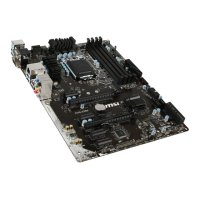

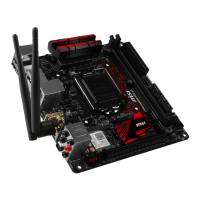
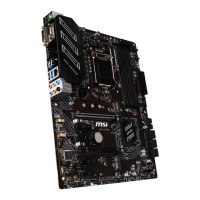
